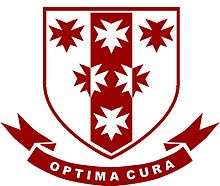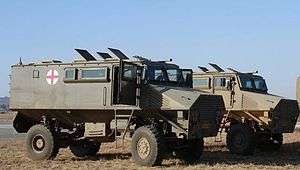6 Medical Battalion Group
| 6 Medical Battalion Group (6 Med Bn Gp) | |
|---|---|
 | |
| Active | 1903 – Present |
| Country |
|
| Allegiance |
|
| Branch | South African Military Health Service |
| Type | Reserve Force |
| Size | 400+ |
| Part of |
South African Department of Defence SAMHS Conventional Reserve |
| Nickname(s) | 6 Med |
| Motto(s) | Optima Cura – Excellence in Care |
| Engagements |
Boer War World War I World War II Border War |
| Website | www.6med.co.za |
| Commanders | |
| Current commander | Colonel M.I. Mogari |
| Insignia | |
| Identification symbol |
 6 Med Bn Gp Nato Code |
6 Medical Battalion Group (6 Med Bn Gp or 6 Med) is a Medical Battalion in the South African Military Health Service (SAMHS), part of the South African National Defence Force (SANDF).[1] As a reserve unit, it has a status roughly equivalent to that of a British Army Reserve or United States Army National Guard unit. It is based in Kempton Park in Gauteng, South Africa.
Background to Military Medical Support in the Transvaal
During the Second Boer War (1889 – 1902), and prior to that time period, there was no organised military medical units within the Boer structures. Hospitals were established however, and medical duties were performed by personnel from European countries.[2]
After the hostilities, it was decided to form a new Transvaal Medical Volunteer Staff Corps,[3] under the leadership of Lt Col D.W. Johnston of Johannesburg. Prior to 1903, the only Military Medical unit on the Witwatersrand was a medical section of the Rand Rifles,[4] and it is probable that the Transvaal Volunteer Medical Staff Corps arose out of this medical section. The Unit was formally established on 20 March 1903, consisting of 4 companies and totaled 400 men.
A further expansion of the Medical Staff Corps to 5 companies, and the establishment of a Nursing Sister’s Reserve consisting of one Matron and 20 Nursing Sisters took place in 1904. These nurses undertook to make themselves available in war and emergency situations to care for the wounded.
Members were armed for their own protection and that of their patients. As a result, rifle drills and drill movements similar to those practised by the infantry received a lot of attention.
The first Sisters to be appointed were Miss M.N. Carston and Miss E.M. Devenish.
This unit served in the Natal Zulu strikes (1906 Natal Native Rebellion), the Johannesburg strikes, South West Africa, East Africa, Madagascar and Italy.
In 1907, a mounted section and a cyclist section was authorised and the total strength reduced to 300 men. On 1 July 1907, the unit changed its name to the Transvaal Medical Corps. It became “Die eerste Veldambulans van die Zuid Afrikaanse Geneeskundige Dienste” (The first Field Ambulance of the Zuid Afrikaanse Medical Services).
In 1908, a Matron, Miss Margaret Patterson, was appointed. The volunteer organisation continued until 1912 when the Union Defence Act came into force, and a Medical Citizen Force was officially recognised and established by publication in the Government Gazette on 9 October 1913, with the Transvaal Medical Corp being disbanded and the new unit being named after embodiment as 1st Field Ambulance (Transvaal) South African Medical Corps.[5]
In June 1913, 1 Field Ambulance (Tvl) was mobilised to assist with the Civil Disturbances and rendered first aid from the Drill Hall in Johannesburg.[6] In 1914 it was mobilised again for Civil Disturbances and established a 50-bed hospital in the Wanderers Club building in Johannesburg. The 1 Field Ambulance SAMC (Tvl) (not to be confused with 1 SA Field Ambulance) was under command of Major J. Pratt-Jones, served in the First Great War and took part in the German South-West Africa Campaign, with the forces that operated from Luderitz under Gen Sir Duncan MacKenzie.
In 1926, the Government awarded Campaign Honours "The Great War - SW Africa 1914-1915 to 1 Field Ambulance SAMC (Tvl).
During World War II, 10 Field Ambulance Unit was established in 1940. This unit served in North Africa during the war in Egypt. Afterwards, 11 Field Ambulance was established and served at El Alamein. This unit was dismantled in 1945 and grouped into two battalions.
On 1 July 1979, the South African Medical Corps (SAMC), until that time a Corps of the Army, became the South African Medical Service (SAMS), the fourth arm of the South African Defence Force (SADF).[7]
6 Medical Battalion Group Founding Structures
6 Medical Battalion Group was established on 1 September 1992 with the consolidation of 2 Medical Battalion Group, 5 Medical Battalion Group, and 6 Medical Battalion Group.[8][9]
2 Medical Battalion Group
2 Medical Battalion Group can trace its roots back to the amalgamation of the following units in 1981:
- 6 Mobile Hospital – established on 1 April 1965 (also known as 9 Field Military Hospital)
- 7 Mobile Hospital
- 10 Field Ambulance
- 13 Field Ambulance – established during 1954(?)
5 Medical Battalion Group
5 Medical Battalion Group can trace its roots back to the amalgamation of the following units in 1981:
- 5 Field Ambulance – dating back to 1903
- 19 Field Ambulance Unit – established on 1 July 1940 (serving in Italy during WW II in the 6th Armoured Division from 21 April 1944 to 2 May 1945.
6 Medical Battalion Group
6 Medical Battalion Group can trace its roots to the demobilisation of the following units on 5 November 1981, and subsequent formation of the Battalion Group on the same date:
- 25 Field Health Company – established in 1965
- 8 Mobile Hospital – established in 1972 (This unit provided the largest contingent of volunteer members to 6 Med Bn Gp during the formation of the battalion on 1 May 1982)
- 81 Field Ambulance Unit – established in 1975
- 9 Field Ambulance Unit – established on 22 August 1961
- 18 Field Ambulance – established in 1940 (Also served at El Alamein)[10]
- Medical Conveyance Unit (Despatch) – established in 1971
6 Medical Battalion Group Headquarters
6 Medical Battalion Group has had various headquarters since establishment on 1 September 1992:
- The disused nurse's kitchen at the old 1 Military Hospital in Voortrekkerhoogte until 1993
- Joint Headquarters with Witwatersrand Medical Command in Braamfontein until 1994
- Joint Headquarters with 7 SA Division in Kensington until 1999
- Joint Headquarters with Gauteng Medical Command in Rietondale until 2008
- Battalion Headquarters in Kempton Park until present
Structure
6 Medical Battalion group is structured on the standard medical battalion as envisaged by the SAMHS for operational support to landward Army groups. It consists of a Command Element, two Operational Wings, one Specialised Medical Support Wing (primarily supporting the Institute of Aviation Medicine), a Clinical Wing, a Force Support Wing (including logistics and human resources) and a Force Preparation Wing (including training and development).
The command structure of the battalion is composed of an Officer Commanding, a Regimental Sergeant Major, a Chaplain, a Chief of Staff, and an Adjutant. Wing Commanders and their Wing Warrant Officers join the command structure to form the Command Group, which jointly manages the affairs of the Battalion under the leadership of the Officer Commanding.
The operational make-up of the battalion includes most of the medical disciplines associated with rendering 1st and 2nd line medical support, with statutory appointments such as Medical Officers, Nursing Officers, Dental Officers and the Operational Medical Orderly.
The following people were appointed as the Officers Commanding of 6 Medical Battalion Group since establishment on 1 September 1992:
Command Structure
| From | Officers Commanding | To |
| 1982 | Commandant F.W. te Groen | 1992 |
| 1992 | Colonel P.F. Coetzee | 2005 |
| 2005 | Colonel A.N.C. Maminze | 2012 |
| 2012 | Colonel A. Ledwaba † | 2014 |
| 2014 | Colonel M.I. Mogari | Present |
| From | Regimental Sergeants Major | To |
| 1982 | Unknown | Present |
Note: Although it is not a specific requirement that the Officer Commanding of a Medical Battalion Group is a Medical Doctor, all of the Officers Commanding to date have been qualified medical doctors.
Honorary Colonel
On 4 July 2008, the then Executive Mayor of Tshwane, Dr Gwendoline M. Ramokgopa was inaugurated as the first Honorary Colonel of 6 Medical Battalion Group at the Tshwane City Hall following a parade through the streets of Pretoria.[11]
Equipment
Weaponry

The main personal weapon of operationally deployed members of the battalion is the R5 assault rifle, whilst Warrant Officers and Officers are usually issued with a 9mm pistol as a personal sidearm. Military health members are not included in the fighting arm of a military force, but are issued weapons for personal protection and the protection of their patients, in line with Article 15 of the Geneva Convention of 1949.[12]
Vehicles

The Mfezi Ambulance is the workhorse of all Operational Medics and the battalion makes use of the 17 ton armoured ambulance during operations.
See also
- NATO Military Symbols for Land Based Systems
- Operational Medical Orderly
- South African military ranks
References
- ↑ "South African National Defence Force Act, Act 42 of 2002" (PDF). dod.mil.za.
- ↑ de Villiers, J.C. Prof, MD FRCS (June 1984). "The Medical Aspect of the Anglo-Boer War. 1899-1902 Part II". Military History Journal. 6 (3). Retrieved 9 January 2015.
- ↑ Pretorius, C.M.L (1982). "DIE SAGD - SY ONTSTAAN EN ONTWIKKELING". Scientaria Militaria. 12 (2).
- ↑ David Biggins. "Anglo Boer War website - Rand Rifles". angloboerwar.com.
- ↑ http://www.scientiamilitaria.journals.ac.za/pub/article/download/618/622
- ↑ "The Drill Hall - Historical Snippets (quoting Col D.R. Smitherman OBE ED)". heritageportal.co.za. Retrieved 8 January 2015.
- ↑ "A Brief History of the South African Defence Force (SADF) 1912 1994. Part 2".
- ↑ "SADF.info". sadf.info.
- ↑ GG/502/1/4 dated 10 February 1982
- ↑ http://www.cgsc.edu/CARL/nafziger/942BJOC.pdf
- ↑ "media statements". dod.mil.za.
- ↑ "1949 Geneva Convention (I) for the Amelioration of the Condition of the Wounded and Sick in Armed Forces in the Field - Centre for International Law". nus.edu.sg.